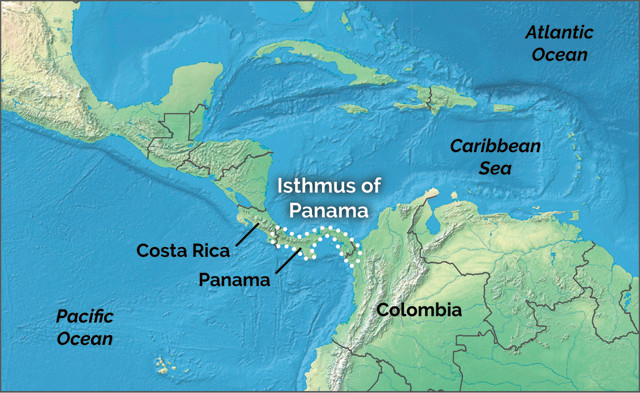
by Mary Caperton Morton Tuesday, December 20, 2016

The formation of the Isthmus of Panama was a pivotal event for organisms on all sides of the narrow strip of land. Credit: K. Cantner, AGI.
The formation of the tiny Isthmus of Panama had major geographic repercussions, cutting off the Caribbean Sea from the Pacific Ocean and connecting North and South America. A new study using multiple lines of geological, biological and molecular evidence supports the most commonly accepted age of the isthmus, about 3 million years, refuting a pair of 2015 studies that placed the closing at a much earlier date.
“The age of the Isthmus of Panama has long fascinated naturalists,” says Aaron O’Dea, a paleobiologist at the Smithsonian Tropical Research Institute in Panama City, Panama, and lead author of the new study, published in Science Advances. The joining of the continents would have facilitated plant and animal migration between the landmasses, while the closing of the waterway between the Atlantic and Pacific Oceans would have led to the divergence of marine species on either side of the narrow strip of land.
The narrow strip of land that makes up the isthmus formed sometime after a volcanic island arc collided with the region about 23 million years ago. Later, uplift of the arc and falling sea levels led to the gradual closing of the waterways between what is now Central America and South America. The timing of the isthmus’ closing has been approximated to about 3 million years, with the primary evidence coming from deep-ocean sediments and paleoceanographic reconstructions that indicate a seaway flowed between the oceans until about that time.
In their new study, O’Dea and colleagues drew upon multiple lines of evidence, including paleontological records of both marine and terrestrial fossils, family tree analysis of shallow-water marine species, and stratigraphic analysis of volcanic and sedimentary rocks, all of which point to a date of 2.8 million years for the formation of the isthmus. “This date [3 million years] has been accepted for over 40 years, standing up against an incredible amount of rigorous scientific evidence,” O’Dea says.
The 3-million-year age was recently contested, however, by two studies that found the isthmus may have formed millions of years earlier. The two competing studies — published by Camilo Montes of the University of Los Andes in Bogotá, Colombia, and colleagues in Science in 2015, and Christina Bacon, formerly of the Smithsonian Tropical Research Institute, now at the University of Gothenburg in Sweden, and colleagues in Proceedings of the National Academy of Sciences in 2015 — found much older dates for the closing of the isthmus, possibly as old as 23 million years.
The Montes paper used zircon crystals to date the formation of a land bridge between the continents to 15 million years ago, whereas the Bacon paper focused on molecular divergence rates of terrestrial and marine organisms on either side of the isthmus, which showed distinctive pulses between 23 million and 20 million years ago and again between 8 million and 6 million years ago. “If true, these [earlier] interpretations would revolutionize our understanding of the timing and causal relationships among environmental, ecological and evolutionary change in the region,” O’Dea says.
In their paper, O’Dea and colleagues directly critiqued the evidence used to support Bacon’s and Montes’ conclusions. Bacon’s study has “missing data and flaws in their assumptions” and Montes’ study relies on an overly complex solution to their land bridge findings, O’Dea says. “It is also interesting to note that the models proposed by Bacon and Montes fail to agree” with each other, he says.
“The timing of the formation of the isthmus has become such a spirited debate,” Bacon says. Everyone in this study could benefit from taking a step back and looking at the general processes involved, she says. “Sometimes when scientists get too close to [our] data, [we] can’t see the forest for the trees.” Bacon and Montes are planning on publishing a formal reply to the O’Dea paper, to address some of the specific criticisms O’Dea’s team made of their studies.
In the meantime, O’Dea and colleagues are encouraging Bacon, Montes and other teams to keep searching for evidence for the age of the formation of the isthmus. “There is much to do, many fossils to collect, much data to analyze and many questions to explore,” he says. “To overturn 40 years of cohesive oceanographic, paleontological and evolutionary research will require a great deal of evidence to the contrary.”
© 2008-2021. All rights reserved. Any copying, redistribution or retransmission of any of the contents of this service without the expressed written permission of the American Geosciences Institute is expressly prohibited. Click here for all copyright requests.